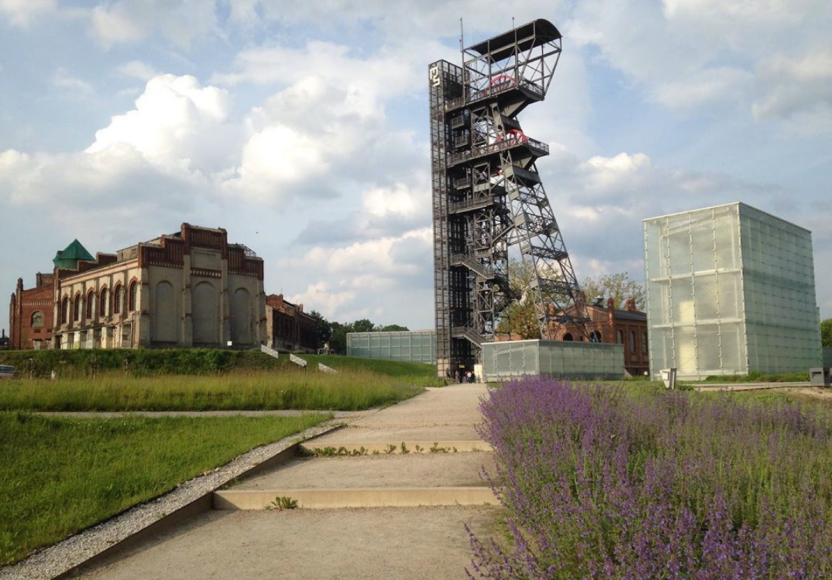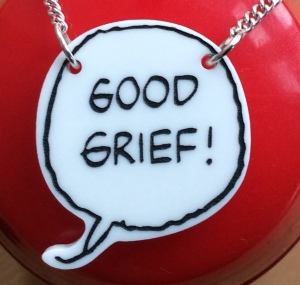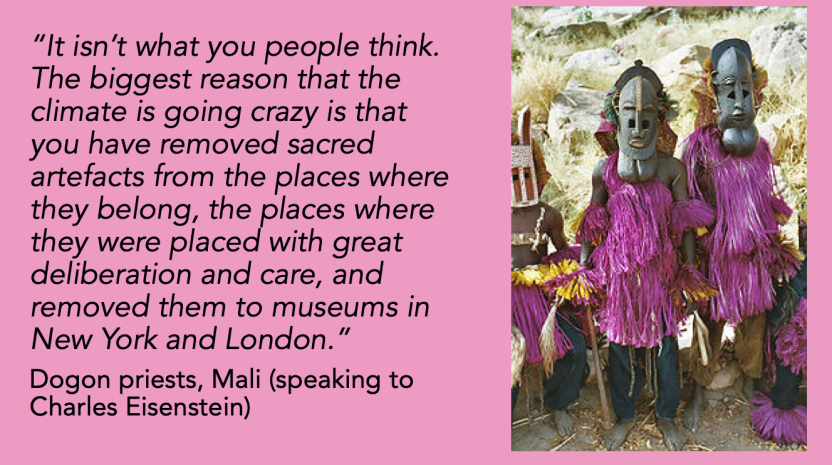
I’m at the We Are Museums conference in Katowice in Poland. The host, the Muzeum Slaskie, has been created out of the site of a disused coal mine. The old buildings now look like chapels, and many of the spaces are underground, lit by light wells. The walls of the auditorium are wood-panelled, bringing to mind the pit props of mines. Trees don’t grow underground but they have been brought here by humans, and long before that, trees have laid down over millennia to form coal, the fuel of the industrial age. Now, 80% of fossil fuels must be left underground. This Museum makes us think about deep time, and the urgency of change.
A key theme of the conference this year, is about how museums can work better with their communities, using their MuseumHood, to tackle climate change. I was part of the panel Museums as Green Revolution Leaders, talking about CMUK, and with Morien Rees (on how museums can be sites of rebellion), Ewa Chomika (on a climate collective emerging in Polish museums), and Dr Kristin Alford on ecologies and futures work at the Museum of Discovery in Adelaide.
I didn’t get enough time to go into any detail about Climate Museum UK, or to spell out my thoughts about how museums can be First Responders in an emergency. I raced through this slide in seconds:

In the morning, Michael Edson from UN Live Museum had talked (via video conference) about museums needing to slice through the Gordian Knot of contemporary challenges, to take direct action now, and not the cautious, passive or slow approach that has characterised museums. His colleague Nikolai Moller talked about the Single Action Bias, where we tend to do one thing and think it is enough.
We start with one step but march on the spot.
I thought I’d come up with some steps forward beyond that first striking out, which museums might make, as a scale of action or a ladder of progress, as ways to respond to the Planetary Emergency (PE). The PE encompasses the breached planetary boundaries, including climate change and biodiversity collapse. I’m not listing small steps of practical action, but describing features that indicate capacity to respond to the PE. I’d argue that in order to progress you don’t need to climb every step. You can fly to the end, if there is leadership and motivation to do so.
First, perhaps we should look at the negative end of the scale, or steps that might be regressive:
- Programmes designed in order to justify or continue consumption or life-destroying industrial practices (e.g. a museum founded by a damaging company or to further a national policy of economic growth based on extraction).
- Accepting sponsorship by fossil fuel or ecocidal companies without question.
And these characterise some kinds of Single Action bias, marching on the spot:
- Only interpreting the PE in terms of reducing the footprint of operations, with no room to expand action
- Not censoring discussion of the PE by artists/staff/audiences, but erasing it in longer-lasting or higher profile communications.
These characterise moving forward, but perhaps still not sufficient as an emergency response:
- Inviting specific audiences for whom the PE is thought to be relevant to come and engage with it (e.g. young people).
- Programming the PE in special events (which are ephemeral, but have wider public reach than above).
- Making symbolic changes and celebrating them to make visible that you care about the PE (but not doing more beyond those actions).
- Programming special exhibitions that address the PE (which are still ephemeral, but allow for deeper engagement and wider reach than events).
Moving more toward the positive end of the spectrum:
- Integrating the PE into permanent displays, buildings and collecting policies as a way towards embedding it in all strands of work or relationships with communities.
- Collaborating with others to learn about how you might respond better.
- Declare a Climate and Ecological Emergency, registering with and joining the community of Culture Declares Emergency.
And this is the point towards which you can fly, if you are so minded:
- Become a First Responder organisation that responds to the PE in ways that underpin its mission, operations, buildings, practices and programmes.
So, to go into more detail about what Museums as First Responders can do:
Think about systems
These times call for urgency, but that means we have to take time to think. Gather resources to think very hard about the big systems causing the Emergency, the mental frames and values behind them, your complicity in these systems, and about the most effective ways to radically change them. This requires setting aside (for a while) concerns about how these changes might risk your stability or safety as an organisation.
For this, you need resources as it is really hard. Listen, for example, to this talk by Daniel Schmachtenberger. Here are some of my blogposts about thinking systemically, and I’m planning more this summer: The Devil is in the Patterns, Beneficial and Harmful, Cause and Effect in Climate and Ecocide, Levelling up Action, Types of Response, and Responses to Thirteen Risks.
Help people cope with loss and change
Acknowledge all the ways that the Planetary Emergency causes anxiety and suffering. On the current course, Business as Usual, the dominant system is extinctionary for vertebrate species and many others. This is unthinkable and devastating, and worse for anyone with intersecting experiences of disadvantage.
This requires three elements in working with people:
- Accept that expressing grief and other sad emotions is essential and helpful, which means accepting this for yourself too (as individuals and colleagues together).
- Being authentic by showing that you are committing to action that will mitigate any stress or suffering people are experiencing.
- Providing resources and concrete ways that help people act, for themselves and for justice for others. For example, welcome activists into the museum, recognising that they may be motivated out of grief.

Safe spaces to imagine
Provide safe (and brave) spaces to imagine possible futures. Museums are not neutral but they can help de-escalate conflict between people, provide space away from stresses in people’s lives and ensure that information is immediately available to enable more sense-making, and more tolerant, open and imaginative dreaming.
‘Safe’ does not mean tame. It is possible to reduce threat while encouraging risky ideas. Do this by creating experiences that enable a felt sense of our connection to each other (and to all other beings). Museums already offer these experiences, so all you may need to do is to invite people and to state the intentions and protocols of safety, risk and imagination.
A key principle is to be Possitopian, to expand horizons about what is possible to avoid being stuck in either Dystopian or Utopian positions. For Possitopian future scoping, use this resource in my set of tools called Possible Culture.
Create a Regenerative Culture
Work with communities to shift to a more Regenerative Culture, for example by educating about, rewarding and actively pursuing a more circular economy, more rewilding of land, more support for a Planetary Commons, using technology to encourage citizen activism, acting for the prevention of Ecocide, and encouraging future work based on ecological innovation. It also means promoting regenerative values for human relationships.
Think about your museum as an agent for birthing a fully beneficial culture and a Circular Economy, where every being benefits, and where open loops in systems are closed.
For a resource, read Daniel Christian Wahl’s book or blog about Designing Regenerative Cultures.
Ecological enterprise
Be sustained by ecological and local enterprise, by changing all operations, retail and relationships with local communities, so that they can be modelled on regenerative principles. Support a local transition from extractive consumerism to providing needs more locally.
This approach is an extension from the point above about birthing a Regenerative Culture, but the key point is that ecological enterprise supports your organisation’s own financial sustainability. For example, if imported food prices rise, it will be helpful to access locally grown food, even better to grow it yourself, and even better to integrate that food growing into educational and participatory programmes.
End the power of the fossil fuel lobbies
Expose truths about the role of fossil fuel lobbies in suppressing environmental action and perverting democracies. Divest from unethical financial services. Refuse partnerships with the fossil fuel industry. You can take the Oil Sponsorship Free pledge.
Expand potential for justice
Prioritise the voices and interests of those whose lifeways and habitats have been displaced, commodified or destroyed by the extractive economy, histories of empire and the unfolding Emergency. These include First Nations or indigenous people, historic diaspora communities and people living in the Global South including refugees. Importantly, it also includes other species.
This shouldn’t be done with a sentimental or nostalgic mindset but to honour, protect and learn from these lifeways. It means, where possible, involving their representatives, or empathising, in ways that show openness to being changed. This means loosening prejudices from any particular cultural mindset, and considering the role of your museum in contributing to the current system.

Protect heritage from direct impacts
The core and long-standing role of museums and heritage conservation is absolutely vital in a time of increasing threats to landscapes such as coastlines, wild ecosystems and urban settlements. The emergency is also a direct threat to collection stores, museum buildings and intangible heritage. Archaeologists, conservationists and natural history scientists working in and with museums need more capacity than ever before to protect and document heritage. They will need to play an active role in local resilience projects such as coastal protection schemes, and advocate for the ‘non-economic losses’ such as sacred sites. See more on Climate Heritage.
